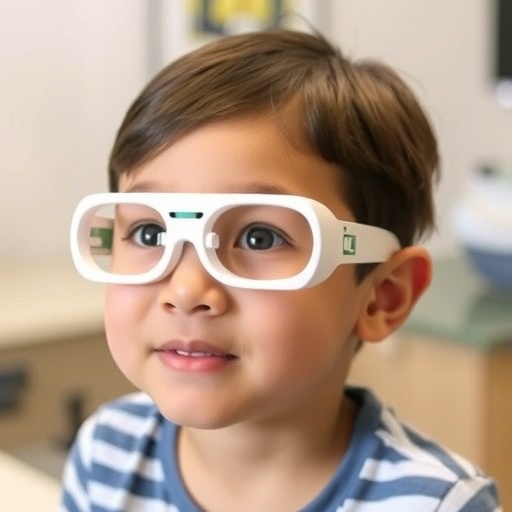In a groundbreaking study published in the Journal of Medical Biological Engineering, researchers have introduced a novel mechanical device designed specifically to enhance accommodative function in myopic school-age children. This innovative flipper, as the study describes, aims to address the increasing prevalence of myopia among children, which has become a significant public health concern globally. The pilot study led by a team of experts, including Yin LT, Lin GC, and Lin CY, investigates the adaptability and efficacy of this mechanical flipper in improving the dynamic visual range of children suffering from nearsightedness.
Myopia, or nearsightedness, manifests when the eyeball grows too long or the cornea is too curved, leading to blurred distant vision. In recent years, the incidence of myopia, particularly in the school-age population, has surged, spurred by factors such as increased screen time and reduced outdoor activities. The authors of the study point out that effective strategies for correcting refractive errors are crucial, yet traditional methods, including glasses and contact lenses, do not sufficiently cater to the underlying accommodative dysfunction observed in many myopic children.
The design of the mechanical flipper is both innovative and user-friendly. The device operates by mimicking the natural movements of the ciliary muscles of the eye, which are responsible for adjusting the lens’ curvature for focusing. By engaging these muscles through mechanical stimulation, the flipper provides an alternative method for children to exercise their accommodative abilities. This approach could help to bolster visual function, potentially decreasing the reliance on corrective lenses over time.
Throughout the pilot study, 30 participants were fitted with the mechanical flipper and subjected to a series of visual assessments to monitor any improvements in their accommodative function. The assessments included various tests designed to evaluate how quickly and effectively the children could adjust focus between near and distant objects. Preliminary results gathered during the study showed significant enhancements in the accommodative response among the participants using the flipper, leading to the conclusion that mechanical assistance could play a vital role in myopia management.
The implications of this research extend beyond immediate visual correction. The findings suggest a potential shift in how optometrists and eye care professionals approach the treatment of myopia in children. By integrating exercises that involve mechanical aids like the flipper into routine eye care, the hope is to foster better long-term visual health among young patients.
Furthermore, the researchers emphasize the importance of early intervention. As myopia progresses, children may face increasing difficulties in learning environments, particularly when it comes to reading and interacting with classroom materials. Enhancing accommodative function could dramatically improve their educational experiences, allowing them to achieve their fullest potential in academic settings.
The mechanical flipper is equipped with adjustable settings, accommodating varying degrees of myopia among the young users. This customization ensures that each child receives a level of mechanical assistance specifically tailored to their visual needs. As a result, the device demonstrates not only versatility but also addresses the unique challenges faced by each individual in their journey towards improved vision.
One of the more intriguing aspects of the study is its potential to spawn a new genre of wearable devices aimed at eye health. With the convergence of technology and healthcare, the mechanical flipper could be the precursor to future innovations, paving the way for advanced solutions focused on preventing myopia and related complications.
Also worthy of mention is the collaborative nature of this research endeavor, which brings together experts from various fields, including ophthalmology, biomedical engineering, and child development. Such inter-disciplinary cooperation is essential for fostering innovation in treatments designed for the younger population, ensuring that research findings are both practical and applicable.
While the results are promising, the researchers caution that further studies are necessary to assess the long-term effectiveness of the mechanical flipper. A larger scale trial is already being planned to involve a more diverse demographic, allowing for a comprehensive understanding of the device’s efficacy across different populations and age groups.
Initial feedback from participants has been overwhelmingly positive, with children expressing greater confidence in their visual abilities during activities both in and outside of the classroom. Parents have also reported noticeable changes in their children’s engagement with educational content, stemming from improved vision and comfort.
As myopia continues to rise at alarming rates, innovative approaches such as the mechanical flipper are crucial in mitigating this public health challenge. The potential this device holds not only enhances our understanding of eye care but also empowers children to take an active role in managing their visual health.
In summary, the mechanical flipper represents a significant advancement in the field of vision correction, particularly for children dealing with myopia. As researchers continue to explore its applications, the hope remains that this novel approach will become a cornerstone of myopia management strategies, ultimately leading to healthier eyes and improved quality of life for countless young individuals around the globe.
Subject of Research: Improvement of accommodative function in myopic school-age children using a mechanical flipper.
Article Title: A Novel Mechanical Flipper for Improving Accommodative Function in Myopic School-Age Children: A Pilot Study.
Article References:
Yin, LT., Lin, GC. & Lin, CY. A Novel Mechanical Flipper for Improving Accommodative Function in Myopic School-Age Children: A Pilot Study.
J. Med. Biol. Eng. 45, 307–313 (2025). https://doi.org/10.1007/s40846-025-00945-4
Image Credits: AI Generated
DOI: https://doi.org/10.1007/s40846-025-00945-4
Keywords: myopia, accommodative function, mechanical flipper, vision correction, children’s health.




